#Nacio Herb Brown
Text

''The Sneak: Novelty Fox-Trot Song'' by Nacio Herb Brown, 1905
Source
134 notes
·
View notes
Text
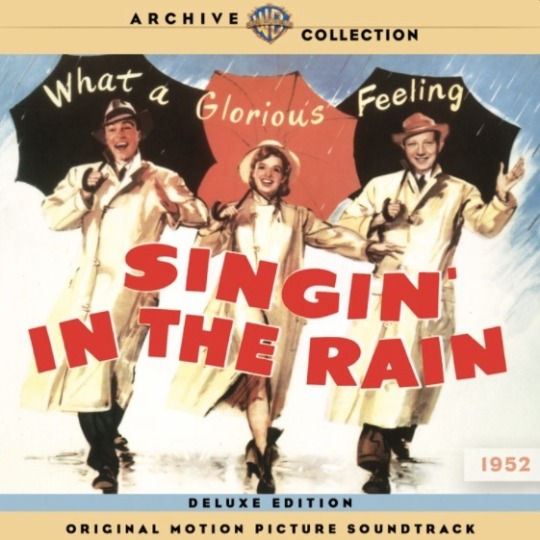

#do you know this musical#musical theater#poll#movie musical#singin' in the rain#gene kelly#stanley donen#adolph green#betty comden#nacio herb brown#arthur freed#language: english
48 notes
·
View notes
Text
youtube
You're all my lucky charms
I'm lucky in your arms
You've opened heaven's portal
Here on earth for this poor mortal
“You Are My Lucky Star” and “I've Got a Feelin' You're Foolin'” from The Broadway Melody of 1936 (1935) – music by Nacio Herb Brown; lyrics by Arthur Freed; performed by Frances Langford and orchestra
2 notes
·
View notes
Text
Good Morning
it's great to stay up late
Good Morning
Good Morning to You!
🆓 "I'm going to spać, good dzień everyone, hakuna matata 👋" - i tyleśmy go widzieli.

#Nacio Herb Brown#Arthur Freed#Judy Garland#Mickey Rooney#Betty Noyes#Gene Kelly#Donald O'Connor#Babes in Arms#Singin' in the Rain#Szogun#Misiek
4 notes
·
View notes
Text
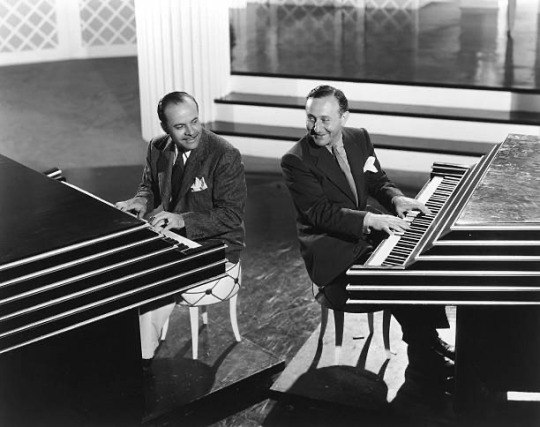
Songwriting partners, composer, Nacio Herb Brown and lyricist, Arthur Freed, circa 1935.
22 notes
·
View notes
Text
youtube
Although the Marx Brothers' 1935 film A Night At The Opera was a success, it took until 1950 for tenor & actor Allan Jones to release a commercial recording of Alone. Originally written by Nacio Herb Brown & Arthur Freed for Jones to duet with Kitty Carlisle in the film, this performance features a beautiful arrangement and lovely delivery.
"There must be someone waiting
Who feels the way I do
Wherever you are, are you, are you
Alone...?"
8 notes
·
View notes
Text
Broadway Melody of 1938, 1937, Is Playing on TCM on June 3 (USA)
Broadway Melody of 1938, 1937, Is Playing on TCM on June 3 (USA)
Broadway Melody of 1938, 1937, is playing on Turner Classic Movies on Friday, June3 at 3 p.m. est The film cost $1,588,000 and made a profit of $271,000 or $4,609,188.57 in today’s money.
Broadway Melody of 1938 is one of those pure escapist type films that folks in the Thirties paid their money to see. It’s a nice film combining both a backstage and a racetrack story with one of the most…

View On WordPress
#1930s#Binnie Barnes#Broadway Melody of 1938#Buddy Ebsen#Charley Grapewin#Eleanor Powell#George Murphy#glamor#Golden Era#hollywood#Igor Gorin#Judy Garland#matinee idol#MGM#nacio herb brown#Raymond Walburn#Robert Benchley#Robert Taylor#Sophie Tucker#TCM
2 notes
·
View notes
Text
Mary Lou Williams' "Free Spirits": A Jazz Odyssey of Timeless Brilliance
Introduction:
In the vibrant landscape of jazz history, certain albums resonate as masterpieces, encapsulating the brilliance of their creators and the spirit of their era. Mary Lou Williams’ “Free Spirits” stands as a luminous gem within this pantheon. Released in 1976, this album is a testament to Williams’ boundless talent as a pianist and composer. Recorded with the exceptional ensemble of…
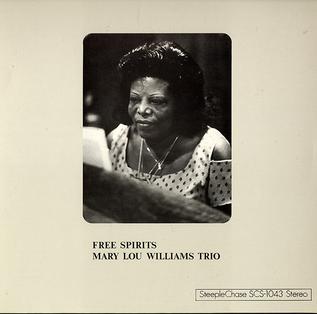
View On WordPress
#Arthur Freed#Bobby Timmons#Buster Williams#Classic Albums#Free Spirits#Jazz History#John Stubblefield#Mary Lou Williams#Mickey Roker#Miles Davis#Nacio Herb Brown#Oklahoma#Oscar Hammerstein II#Richard Rodgers#Timme Rosenkrantz
0 notes
Text
Singing in the Rain, illustrated by Tim Hopgood. Based on Arthur Freed and Nacio Herb Brown’s song
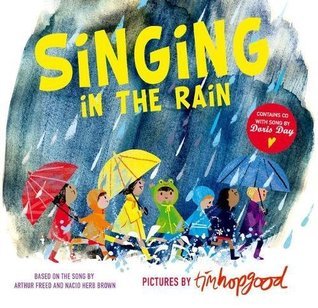
Age Recommendation: Early Learning
Topic/ Theme: Rain and Happiness
Setting: Gobal
Rating: 4/5
This is such a lovely and colourful book. The rainbow and fun of the raincoats shine so wonderfully through the rain. The characters travel all over, seeing different parts of the world some easily distinct, others less so. This provides something new to see on every page. From animals to flowers to expressions. It is a book that will grow with readers. The illustrations are created through watercolours and pencil, a perfect choice given the rain theme. The watercolour adds the right tone and feel to rain. There is some diversity in the cast of children singing in the rain. I appreciate the choice to include the musical notation as well as the lyrics which form the words of the book.
This edition comes with the book read by British actress Sophie Aldred and a recording of the titular song by Doris Day, available on YouTube (it was unlistenable on my copy). That book reading is wonderful not so much for Aldred's skill as a reader but for the backing track. Through the illustrations, there are animals, clear setting markers in the backing track these are reflected. Rainforests, birds, splashing puddles. It's just really appealing. As is the chime to change the page and that was a sound of my childhood. I used to listen to books like this as a child. I had completely forgotten that until I heard that sound.
This really is a book for all ages. While the intended audience is children Tim Hopgood has kept the adults in mind. In his author note Hopgood says "As adults, we tend to think of rain as an inconvenience rather than the joyous thing that it is. Next time it rains, step outside, feel the rain and give the clouds up above your biggest smile!"
#singing in the rain#picture story#tim hopgood#arthur freed#nacio herb brown#book review#ktreviews#read 2022#booklr
1 note
·
View note
Text
'Singin' in the Rain' – Gene Kelly's gotta dance on HBO Max
‘Singin’ in the Rain’ – Gene Kelly’s gotta dance on HBO Max
Singin’ in the Rain (1952) has been hailed as the greatest American musical ever made. It’s certainly one of the most fun, a knockabout reimagining of the transition from silent to sound movies: lousy history but a blast of singing, dancing, romancing energy and color.
Gene Kelly is Don Lockwood, the vaudeville schlub turned movie stuntman and finally matinee idol. His introduction is brilliant,…

View On WordPress
#Adolph Green#Arthur Freed#Betty Comden#Blu-ray#Cyd Charisse#Debbie Reynolds#Donald O&039;Connor#DVD#Gene Kelly#HBO Max#Jean Hagen#Kathleen Freeman#Millard Mitchell#Nacio Herb Brown#Stanley Donen#VOD
1 note
·
View note
Text

Christopher Gable and Twiggy in The Boy Friend (Ken Russell, 1971)
Cast: Twiggy, Christopher Gable, Max Adrian, Bryan Pringle, Murray Melvin, Moyra Fraser, Georgina Hale, Sally Bryant, Vladek Sheybal, Tommy Tune, Brian Murphy, Graham Armitage, Antonia Ellis, Caryl Little, Glenda Jackson. Screenplay: Ken Russell, based on a musical play by Sandy Wilson. Cinematography: David Watkin. Production design: Tony Walton. Costume design: Shirley Russell. Music: Peter Maxwell Davies; songs: Sandy Wilson, Nacio Herb Brown, Arthur Freed.
Nothing succeeds like excess. That seems to have been Ken Russell's motto, well displayed in The Boy Friend. As I watched it, I thought the first parody of Busby Berkeley's kaleidoscopic production numbers for Warner Bros. musicals was brilliant. The second was entertaining. The third was ... well, maybe the law of diminishing returns had set in. The original stage musical was a campy sendup of the kind of musical comedies that P.G. Wodehouse, Guy Bolton, and Jerome Kern used to create for the Princess Theatre and later in the 1920s: tuneful light romances with silly plots. But for the movie, Russell superadds a campy sendup of the backstage movie musicals of the 1930s, borrowing plot and even dialogue from 42nd Street (Lloyd Bacon, 1933), hence the Berkeley parodies. I first saw The Boy Friend around the time of its first release, and enjoyed it. But watching it again now, I found myself looking at the clock after the first hour and a half passed. The version I had seen in the theater was the one MGM had cut by 25 minutes; the restored version runs an exhausting two hours and 17 minutes. That said, there is much to enjoy about Russell's movie, especially the vividly colored production design by Tony Walton and costumes by Shirley Russell (the director's wife). The presence of the great Tommy Tune in the cast is also a plus. The Sandy Wilson songs are pleasantly hummable, and the interpolation of two songs by Nacio Herb Brown and Arthur Freed that were featured in Singin' in the Rain (Stanley Donen and Gene Kelly, 1952) is nice. But a little camp goes a long way, and piling camp on camp can be tiresome, especially if the camp is done the way Russell does it: with a smirk rather than a wink.
12 notes
·
View notes
Text
Muppet Mainstage, April 6th, 2024
youtube
“Temptation” was written by Nacio Herb Brown and Arthur Freed in 1933. It made its muppet debut in the first episode of The Muppet Show (1976). The song was performed by The Muppet Glee Club, conducted by Kermit (Jim Henson) and with Miss Piggy. This instance is interesting because while Frank Oz did her speaking voice, Richard Hunt did her singing voice (which is the only time Richard Hunt would sing as Piggy).
8 notes
·
View notes
Text
What a glorious feeling
Script below the break
Hello and welcome back to The Rewatch Rewind! My name is Jane, and this is the podcast where I count down my top 40 most frequently rewatched movies in a 20-year period. Today I will be discussing number four on my list: MGM’s 1952 musical Singin’ in the Rain, directed by Stanley Donen and Gene Kelly, written by Betty Comden and Adolph Green, and starring Gene Kelly, Donald O’Connor, and Debbie Reynolds.
It's 1927 and silent film stars Don Lockwood (Gene Kelly) and Lina Lamont (Jean Hagen) have just premiered another smash hit. To escape from a mob of fans, Don jumps into the car of Kathy Seldon (Debbie Reynolds), who is surprisingly unimpressed by him, which he is both insulted and intrigued by. Weeks later, when Don is still focused on trying to find Kathy again, and his friend Cosmo Brown (Donald O’Connor) is running out of ways to get him to snap out of it, the success of Hollywood’s first talking picture prompts the studio head to turn the next Lockwood and Lamont film into a talkie, and Don’s life – and Hollywood itself – will never be the same.
This is a very important movie to me because in a way, it’s the one that started it all. My love for Old Hollywood began in a movie theater at a 50th anniversary screening of Singin’ in the Rain. I’ve mentioned in several previous episodes that I started getting into Old Hollywood in 2002 – this is why. My mom took me to see it, and then based on my reaction started introducing me to more of her faves from around this era, and here I am, 21 years later, still loving these films. I can’t remember exactly when I watched Singin’ in the Rain the second time; I might have seen it again in 2002, I don’t know. But I believe it was 2003 when we bought it on VHS while on a family road trip. We had a little TV/VCR that we used to set on top of a cooler behind the front seats, held in place with bungee cords. I could not get enough of this movie and insisted on watching it probably way more times than my siblings wanted on that road trip, although I think they enjoyed it too, just not quite to the extent that I did. I watched it seven times in 2003, six times in 2004, three times in 2005, once in 2006, once in 2007, twice in 2009, once in 2010, once in 2011, twice in 2012, once in 2013, twice in 2015, once in 2016, once in 2019, once in 2020, once in 2021, and twice in 2022. I can’t remember when, but at some point I ended up with a DVD in addition to the VHS. And one of my 2022 watches was in a theater for the 70th anniversary. While in many ways that was a very different experience from the first time I saw it, since every moment of the movie was deeply familiar rather than fresh and new to me, it felt no less magical. I still love this movie just as much as, if not more than, the first time I watched it, and I am so grateful that it introduced me to a world of films from generations before my time.
There is so much to love about this movie that I don’t even really know where to start. The dialogue is clever and delightful, the casting was perfect and the performances are brilliant, the costumes, sets, and lighting are gorgeous, and the music makes you feel like you’ll never be unhappy again. In some ways, it’s actually kind of similar to Mamma Mia, in that it’s a jukebox musical. Like how Mamma Mia took popular ABBA songs and loosely draped a story around them, Singin’ in the Rain took a bunch of old songs, mostly written by MGM producer Arthur Freed (who came up with the idea) and Nacio Herb Brown, and tied them together with a story. I will say I feel like the story of Singin’ in the Rain works quite a bit better, mainly because the subject matter fits the songs so well. It was a stroke of genius to make the movie that would feature songs from early talkies be about early talkies. Freed and Brown did write one new song specifically for this movie, “Make Em Laugh,” but it bears a remarkable resemblance to Cole Porter’s “Be a Clown” from the 1948 Freed-produced film The Pirate. Screenwriters Comden and Green wrote the “Moses Supposes” song based on an existing tongue-twister, but all of the other songs in the film had been featured in at least one previous movie. These days, Singin’ in the Rain is such a beloved, iconic movie that many of the songs’ origins are all but forgotten, and they’re generally associated with this picture. But it’s always kind of fun to be watching some random old movie that predates this one and hear one of these songs pop up. Probably my favorite instance of this is in Adam’s Rib, which was number 27 on this list and made in 1949, when Tom Ewell’s character is going to visit his mistress, played by Jean Hagen, he’s whistling “You Are My Lucky Star,” and I love that both that song and that actress ended up in this movie three years later.
A big part of what makes Singin’ in the Rain such a perfect introduction to Old Hollywood is that the songs are from Old Hollywood and the story is about Old Hollywood. It’s so fascinating to watch the characters figuring out the technical aspects of adding sound to a medium that modern audiences automatically associate with sound. But even beyond that, this movie breaks the illusion of Hollywood glamor while still sort of trying to hide behind that illusion, in a way that almost feels like it’s laughing at itself. So much of the story is about how movie magic relies on facades and deception. The movie starts with a red-carpet interview where Don tells of his rise to fame and his motto: “Dignity, always dignity,” while the audience sees flashbacks of his very undignified beginnings. Lina is on screen looking quietly glamorous for about 10 minutes before she finally speaks, revealing what the silence of her films has concealed: her voice is almost unbearably squeaky and obnoxious. So in order to make her presentable in a talking picture – which eventually becomes a musical – her voice is dubbed by Kathy. Initially the plan is to credit Kathy as Lina’s voice and use this to help launch her to stardom, but Lina threatens to sue the studio unless they force Kathy to be her voice indefinitely without credit. I don’t think it was usually quite that dramatic, but uncredited dubbing happened all the time. In previous episodes, I’ve mentioned Marni Nixon, who dubbed the singing for many iconic performances, such as Audrey Hepburn in My Fair Lady and Natalie Wood in West Side Story, without credit at the time, although now her contributions are kind of general knowledge, at least among movie buffs. But we don’t even have to go that far to find an example: it happened in Singin’ in the Rain itself! Betty Noyes, also known for singing “Baby Mine” in the Disney movie Dumbo, sang for Debbie Reynolds in a couple of her songs without credit, notably including “Would You?” which Kathy is meant to be dubbing for Lina. So Betty Noyes sang for Debbie Reynolds when she was singing for Jean Hagen. (Part of the time, anyway. The “Singin’ in the Rain” reprise that Kathy sings for Lina behind the curtain was definitely Debbie Reynolds’s voice.) Even more ironically, when Kathy is dubbing Lina’s dialogue (“Nothing can keep us apart, our love with last ‘til the stars turn cold”), that was Jean Hagen’s normal speaking voice, so Jean Hagen dubbed Debbie Reynolds dubbing Jean Hagen. I just can’t get over how blatantly these filmmakers went, “Hollywood is fake and yes that includes us” – although I suppose it was much less blatant at the time, I’m not sure at what point all of this became so well-known.
Learning about the dubbing didn’t decrease my love for this movie, although some of the other behind-the-scenes trivia kind of did – specifically the fact that nobody seemed to have a very good time working with Gene Kelly because he was so demanding and impatient, particularly with then 19-year-old Debbie Reynolds, who was not a very experienced dancer, which Kelly found exasperating, even though he knew about it when she got the role. Apparently at one point Fred Astaire – also a notoriously demanding perfectionist – found her crying under a piano at the studio and offered to help her with her dancing. She learned fast and committed hard, literally bursting blood vessels in her feet during the “Good Morning” number. Reynolds later famously said that Singin’ in the Rain and childbirth were the two hardest things she ever had to do. Not that she was the only one who worked hard. Gene Kelly was sick with a 103-degree fever when he performed one of the most famous scenes in Hollywood history, dancing and singing to the title song. I used to view this as admirable, but now I’m like, maybe they could have waited to film it until he got better? Similarly, Donald O’Connor, who was smoking four packs of cigarettes a day at the time, had to rest in the hospital for several days after filming the “Make ‘Em Laugh” scene, and again, it’s like, it’s an incredible performance in a great number, but was it really worth going to the hospital for? Both the story within this movie and the story of how it was made raise some very interesting questions about the “point” of motion pictures – as art, as entertainment, and as an industry – that are still being wrestled with today. Personally, I don’t believe anyone should be forced to risk their health for their job, but at the same time I appreciate how dedicated everyone involved was to making this masterpiece the best it could possibly be. It certainly paid off in this instance. It’s easy for me to say now that it would have been worth making a slightly worse movie if that meant protecting the well-being of the actors, but maybe if it was worse I wouldn’t have quite fallen in love with it to this degree and my life would look very different. So I still don’t know how to feel about all this. And I don’t even know how much it matters anymore, given that the only major cast member still alive is Rita Moreno, whom I absolutely would not have recognized without seeing her name in the credits, and I don’t think she personally was injured on this set – although she was originally supposed to sing “I’ve Got a Feelin’ You’re Foolin’” which then got absorbed into the “Beautiful Girl Montage” that she wasn’t part of, which is a major bummer because she deserved a bigger role in this.
Anyway, speaking of complicated feelings, let’s talk about the romantic aspects of Singin’ in the Rain. The romance between Don and Kathy is an important part of the story, and while that’s a little disturbing knowing how terribly Kelly treated Reynolds on set, and that he was approximately twice her age, their characters’ relationship within the movie is mostly very sweet and I don’t really have a problem with it. And I appreciate how much screentime is devoted to the friendship between Don and Cosmo, which Don is shown continuing to value just as much as he always did even after he starts seeing Kathy. It’s always great to see characters refusing to follow the amatonormative idea of a relationship hierarchy, with every other relationship falling far below one’s romantic partnership. I love the scene in Don’s house that leads to the “Good Morning” number partly because it’s an important turning point in the story and it’s a great song, but also because it shows Don and Kathy and Cosmo as a trio, not a couple with a third wheel, which is so lovely to see. But though Don does his best to resist amatonormativity, it still pursues him rather relentlessly in the form of his costar, Lina Lamont. The studio leaks rumors that Don and Lina are romantically involved to increase publicity for their films, and Lina seems to believe them, despite Don’s adamant assertions that, “There is nothing between us. There has never been anything between us. Just air.” Their relationship is yet another example of a Hollywood façade, and one of my favorite scenes is when they’re working on a silent film and pretending to be madly in love when they’re in the middle of a fight. Their scene ends with a kiss, and as soon as the director yells, “Cut!” Don pushes Lina away in disgust, but she is so sold on their romance that she says, “Oh Donny, you couldn’t kiss me like that and not mean it just a teensy weensy bit!” to which he retorts, “Meet the greatest actor in the world! I’d rather kiss a tarantula!” It would be easy to attribute many of Lina’s actions to jealousy after Don falls in love with Kathy, which was definitely an important motivation, but it wasn’t her only motivation. Because while she is portrayed as relatively clueless, she has to know that the rise of talking pictures is bad for her. It’s not just that she’s losing her man, she’s also losing her career. When she tries to use her star power to force Kathy to work solely as her voice, part of that is certainly to get in the way of Don and Kathy’s happiness together, but I would argue that more of it was a desperate attempt to remain in an industry that was moving on without her. Lina is portrayed as the villain, and granted some of the things she does are pretty awful, but at the same time one can’t help feeling sorry for her. She was taken in by the glamor of Hollywood, unable to see that everything from her romance to her popularity was make-believe, and suddenly her entire life is crashing around her. We cheer when the curtain opens to reveal that Kathy is singing for Lina, but we also cry for her a little – at least, I do. I find Lina to be a thoroughly fascinating and compelling character, and Jean Hagen gives one of my all-time favorite performances (she was nominated for an Oscar and absolutely should have won), and I really want to know what happens to her after the events of the movie. Hopefully she realizes that she doesn’t need a man, least of all one who hates her like Don does, and finds a new career that makes her happy.
If being a Lina Lamont apologist doesn’t get me kicked out of Old Hollywood fan circles, this might: I don’t understand why Cyd Charisse is in this movie. I get that the “Broadway Melody” number is a gorgeous spectacle, but it doesn’t have anything to do with anything and it goes on way too long, and in world it makes zero sense. First of all, they have six weeks to basically remake their entire movie, and that number alone would have absolutely taken more than six weeks to put together. Secondly, a big part of the appeal of that number is how colorful everything is, but their film is in black and white. And like, okay, we can suspend disbelief and just accept that, but there is absolutely no way that Lina Lamont would put up with a 15-minute musical number in the middle of her picture, in which, not only does she not appear at all, but Don is dancing very suggestively with another woman. Like, come on. I know that having a random ballet toward the end of a musical was a major thing back then, especially in Gene Kelly films, but that has never made sense to me and it never will. And like, why did they give Cyd Charisse a very distinctive look for most of her part and then change it for the ballet so that she’s barely recognizable? It’s so confusing. Don’t get me wrong, I mean no disrespect to Charisse, she was a wonderful dancer, and I think it’s great that her appearance in this movie helped put her on the map and lead to bigger roles for her, it’s just that that scene is my personal least favorite part of the movie. Although I guess the message of that whole number can be boiled down to, “when romance fails, turn to your hobbies,” which is something I can definitely get behind. So maybe I wouldn’t cut it out entirely; I would just make it significantly shorter so we can get back to the main story faster.
The thing I find so compelling about this movie is that while it exposes Hollywood glamor as a sham, it also shows that when you see through that, there’s often still something valuable underneath. The smoke and mirrors of movie magic add to the entertainment value, but fundamentally, movies are stories, and storytelling is a deep-rooted feature of humanity. Sometimes when I tell people that I enjoy old movies, they assume that means I’m into the fancy costumes and larger-than-life stars, and like, I guess that’s part of it, but mostly I just really enjoy good stories that are told well, and that’s what a lot of old movies are. And it’s not just Hollywood that tries to glamorize people and their stories; our whole society does it, too, only to a slightly lesser extent. Just as Lina needed to conceal her unpleasant voice and the studio felt that Lockwood and Lamont would sell more tickets if people thought they were actually dating, or just as people thought Debbie Reynolds’s voice wasn’t strong enough for all of Kathy’s songs, normal people in everyday life feel the need to disguise facets of their identity that are less socially acceptable. Don’t act too queer, conform to your assigned gender role, don’t infodump about your hyperfixations; in short, put on a show to pretend to be “normal.” But just as nobody is really as glamorous and flawless as movie stars’ personas pretend to be, nobody is really normal either. Hopefully our society will someday get to the point where people don’t have to keep up this façade, and perhaps future movies will reflect that. But for now, it’s difficult to imagine a more perfect illustration of how the film industry reflects society than the layered deceptions of Singin’ in the Rain. It’s sort of halfway between satire and an honest reflection, and it works remarkably well as both. But it’s also very easy to just watch it as a fun musical without thinking too hard about any of this. I just happen to greatly enjoy overthinking the stories I love, and this happens to be one that lends itself to much overthinking, which is one of the many reasons why I love it.
Thank you for listening to me discuss another of my most frequently rewatched movies. It’s getting to the point where I know these movies so well that I’m not really sure how to talk about them to people who haven’t seen them, so if you’ve never watched Singin’ in the Rain and still managed to follow this episode, I’m very impressed. Next up is a movie that I’m pretty sure would be number one on this list if I’d started keeping track about two years earlier because I already had it completely memorized before 2003, but in the 20 years I was tracking I watched it a mere 35 times, leaving it at number three. As always, I will leave you with a quote from that next movie: “Well. Someone’s got to break the ice and it might as well be me. I mean, I’m used to being a hostess, it’s part of my husband’s work, and it’s always difficult when a group of new friends meet together for the first time, to get acquainted, so I’m perfectly prepared to start the ball rolling. I mean, I have absolutely no idea what we’re doing here, or what I’m doing here, or what this place is about, but I am determined to enjoy myself, and I’m very intrigued, and oh my, this soup’s delicious, isn’t it?”
#singin in the rain#stanley donan#gene kelly#donald o'connor#debbie reynolds#jean hagen#the rewatch rewind
6 notes
·
View notes
Photo
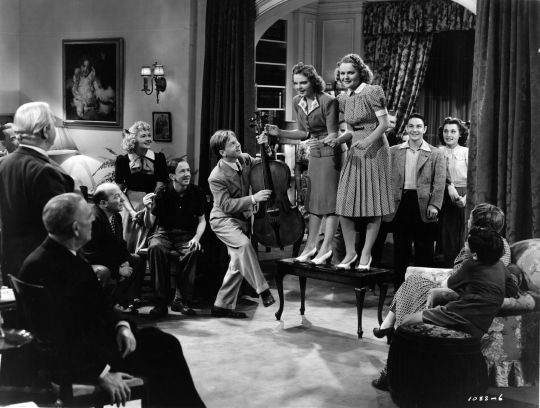
Babes in Arms (1939)
When did the “theater kid” stereotype become a term of dismissal? Through my secondary school days (and this goes for those in secondary education at the present time, too), the theater kid designation was always derisive, to denote classmates too obsessed with musical theater and often keeping to their own clique. Being an orch dork myself in those days, I found myself in an awkward middle ground: understanding fully a theater kid’s love of musical theater, yet a bit intimidated by their devotion to the medium.
The above is a circuitous way to ironically note that I have never been uncomfortable with Metro-Goldwyn-Mayer’s (MGM) hey-kids-let’s-put-on-a-show musicals of the 1930s and ‘40s. Central to that subgenre of musical at MGM were Judy Garland and Mickey Rooney – both embodying, in most of their ten joint movie appearances from 1937-1948, the traits identifiable to anyone who understands how theater kids behave. Their movie musical collaborations contain no narratives of note, just sheer musical and choreographic virtuosity that holds up more than eighty years later. Babes in Arms, directed by Busby Berkeley, is the first of Berkeley’s unofficial “Backyard Musical” series starring Garland and Rooney – later followed by Strike Up the Band (1940) and Babes on Broadway (1941). Having seen only the middle film of that trilogy before, Babes in Arms is the weaker of the two I have completed. But for a roughly ninety-minute romp with puffed-up adolescent drama and a modest budget, Babes in Arms is decent value for those interested in movie musicals and the filmographies of those involved.
It is 1921 somewhere in America. Vaudeville patriarch Joe Moran (Charles Winninger) announces the birth of his only child, a son. Fatefully, his son is literally born on stage. Fast forward to the late 1930s and we find Joe’s son, Mickey (Mickey Rooney) teaming up with girlfriend Patsy Barton (Judy Garland; whose character comes from a different vaudeville family) to sell one of his songs to a music publishing company. He’s on piano; she’s the singer as they perform “Good Morning” (yes, that same song Gene Kelly, Debbie Reynolds, and Donald O’Connor hoofed so magnificently to in 1952’s Singin’ in the Rain). The publishers unsurprisingly purchase Mickey’s song. $100 (more than $2,000 in 2022’s USD) in hand, Mickey returns home to his parents but is aghast to learn that his parents – who left the vaudeville circuit shortly after the 1927 introduction of synchronized sound in movies – are heading back on tour without him. To convince his parents to bring him along, he and Patsy piece together a plan that any spurned child might pursue: to put on a show with the other musically talented kids in the community (deeming themselves the “Babes in Arms”).
Teenage drama ensues including an unnecessary physical assault, a preventable love triangle, and an unfortunate decision to use blackface (more on this later). The cast also includes Grace Hayes as matriarch Florrie Moran, Margaret Hamilton as busybody Martha Steele, Rand Brooks as Martha’s nephew, Guy Kibbee as a judge, and June Preisser as the third side of the aforementioned love triangle with an unfortunate nickname. Betty Jaynes plays Mickey Rooney’s elder sister while Douglas McPhail plays Don Brice, one of the older kids with an underutilized baritone.
Babes in Arms is technically based on composer Richard Rodgers and lyricist Lorenz Hart’s 1937 stage musical of the same name. And though Rodgers and Hart are credited, this film adaptation resembles little of their original work, with only two songs from the stage musical retained for this movie. “The Lady Is a Tramp” appears only in the score, while the title song and “Where or When”. “Babes in Arms” appears as Mickey Rooney rounds up the neighborhood teenagers to march militarily down the roads – crates and (gulp) torches in hand. With even brief quotations of “Ride of the Valkyries” from Wagner’s Die Walküre in the song (2:53 in provided video), these kids, however well-dressed, might be taking on their newest task too exuberantly. “Where or When”, a ballad that few ever seem to mention, is sung beautifully by Douglas McPhail and Betty Jaynes; the inclusion of the little children on their one-quarter or half-sized string instruments is a charming touch. Garland briefly sings “Where or When” too, and one just wishes she could carry the song to its conclusion.
Among the MGM musical entries, most will recognize “Good Morning” (music by Nacio Herb Brown, lyrics by Arthur Freed) during Rooney and Garland’s attempt to sell the former’s song to the publishing agency. This original rendition of “Good Morning” does not have the choreographic mastery as seen in Singin’ in the Rain, but it certainly establishes that easygoing dynamic audiences would see often between Garland and Rooney.
youtube
By the time the film hits the stage show that concludes Babes in Arms, Mickey, Judy, and company will have sung quite the gamut of musical numbers. Separating themselves from most of the soundtrack are “Daddy Was a Minstrel Man” and “God’s Country”. The former (music and lyrics by Roger Edens) opens the stage show and is the first part of a sequence where both Judy Garland and Mickey Rooney don blackface. Blackface, which originated from American minstrel shows in the early nineteenth century, is a theatrical device in which a typically non-black person wears makeup to portray a happy-go-lucky caricature of a black person. This offensive practice predates cinema and serves no useful performative or cinematic purpose – a non-black performer can pay homage to black culture without perpetuating stereotypes, such as applying blackface. Unfortunately, both Garland and Rooney would be in blackface again in the last film of the Backyard Musical trilogy, Babes on Broadway. For some, “Daddy Was a Minstrel Man” and the following song, “I’m Just Wild About Harry” (a 1921 number with music by Eubie Blake and lyrics by Noble Sissle), will be distracting, to say the least. Together, they smash the picture of teenage innocence that (mostly) courses through Babes in Arms.
“God’s Country” is unabashed American flag-waving that proclaims the U.S. as a divinely dynamic nation. Briefly quoting the melody from “Yankee Doodle”, the song – considering that the United States was, at this time, a mostly insular nation that would rather not be involved with the mounting tensions in Europe and Asia – offers some curious lyrics, such as celebrating American freedom with this:
A hundred million rooters can’t be wrong,
So give a hand, give a hand,
Give a cheer for your land,
Where smiles are broader, freedom greater.
Every man is his own dictator.
Even more surprising lyrics appear shortly after that lightly rib the soon-to-be Axis nations:
We’ve got no Duce;
We’ve got no Führer.
But we’ve got Garbo and Norma Shearer.
Got no goose step;
But we’ve got a Suzie Q step
Here in God’s country!
For a movie made before and released after Nazi Germany’s invasion of Poland, this is as strong a criticism as one might expect from a major Hollywood movie at this juncture. Through most of the 1930s, every major Hollywood studio except Warner Bros. heeded the demands and threats of Los Angeles-based Nazi Germany diplomat Georg Gyssling, who suggested edits on certain screenplays to root out any critique of Germany and Nazism. This cinematic appeasement was sweeping, but it appears that Gyssling and his associates missed a small detail in Babes in Arms.
Other than the wall-to-wall soundtrack, the main attraction for Babes in Arms are its two co-stars. Still teenagers, Rooney and Garland were given an adult’s workload. Including both feature films and shorts, Babes in Arms was Mickey Rooney’s ninety-sixth of ninety-eight films of the 1930s. Somehow, Rooney, already one of MGM’s brightest lights thanks to the Andy Hardy series (1937-1958), is abundantly manic and tireless here in his first movie musical. Even in comparison to the exhaustingly hyperactive of mainstream American filmmaking, Rooney’s enthusiasm almost leaps off the screen. For her part, Judy Garland was not a household name yet when she trotted in front of the camera to film Babes in Arms. Her performance is not quite assured here, and any hint of believable romance between her and Mickey Rooney is spotty more often than not in part due to a sloppy screenplay. By the time of the film’s release, The Wizard of Oz (1939) had already been out in theaters for more than a month. History correctly regards The Wizard of Oz as an essential film, but Babes in Arms grossed more at the box office in 1939. Babes in Arms cemented a career 1939 for Judy Garland, which, just before the film’s premiere, also saw her lay her hands and feet in the cement at Grauman’s Chinese Theater.
Director Busby Berkeley (choreographer on 1933’s 42nd Street and Gold Diggers of 1933) made a name for outlandish mass choreography, but his choreographic style fell out of fashion by the end of the 1930s. Babes in Arms is pedestrian work from the master visualist, but it also marks the beginning of lyricist Arthur Freed’s (1943’s Cabin in the Sky, 1951’s An American in Paris) career as an MGM producer. Within the MGM hierarchy, the “Freed unit” was an assemblage, under Freed’s leadership, of actors (many of whom were principally stage actors before signing up with MGM), composers and lyricists, writers, and directors with the express purpose of crafting movie musicals with little executive interference. Babes in Arms does not yet quite contain that artistic freedom of an Arthur Freed musical, but many of the personnel in front of and behind the camera would become key contributors to the Freed unit.
As manufactured and predictable as much of Babes in Arms’ drama might be, I find it still quite watchable. Several statements from Mickey Rooney decades after completing this film perhaps explain why. In any case that the Backyard Musical trilogy comes up in a Mickey Rooney interview, Rooney usually noted how semiautobiographical these films were for himself and Garland. Both came from vaudevillian families; public performance as natural to them as breathing. Garland and Rooney spent much of their lives on a stage – theater kids, if you will – and derived profound happiness from performance. Even when surrounded by disagreeable, perhaps abusive, persons while making these movies (there are indications that Berkeley was difficult towards Garland, who was already enduring MGM head Louis B. Mayer’s cruel barbs regarding her physical appearance), that desire to embolden and transport others remains.
Babes in Arms might not be to the liking of those who still disdain theater kids, nor any of the Backyard Musicals. For others like yours truly, who appreciate the musicality and energy on display but never quite belonged to either extreme, Babes in Arms is lighthearted entertainment, flawed in execution, honestly acted.
My rating: 6/10
^ Based on my personal imdb rating. My interpretation of that ratings system can be found in the “Ratings system” page on my blog (as of July 1, 2020, tumblr is not permitting certain posts with links to appear on tag pages, so I cannot provide the URL).
For more of my reviews tagged “My Movie Odyssey”, check out the tag of the same name on my blog.
#Babes in Arms#Busby Berkeley#Mickey Rooney#Judy Garland#Charles Winninger#Guy Kibbee#June Preisser#Margaret Hamilton#Jack McGowan#Betty Jaynes#Douglas McPhail#Kay Van Riper#Richard Rodgers#Lorenz Hart#Arthur Freed#Nacio Herb Brown#Roger Edens#TCM#My Movie Odyssey
9 notes
·
View notes
Text

Singing in the Rain (Full Song/Dance - '52)
Gene Kelly - Musical Romantic Comedies - 1950s Movies
youtube
The complete title song and dance, Gene Kelly (also co-director with Stanley Donen and choreographer) as movie star Don Lockwood, tune by Nacio Herb Brown, lyrics by Arthur Freed, in the Best Picture-winner made by his famed Freed Unit at MGM, SINGIN' IN THE RAIN ('52).
Singing and dancing in the Rain. Remix style.
youtube
2 notes
·
View notes
Text
Photos of Singin' in the rain with Stefán Karl
All photos were taken from mbl.is
First two photos were taken by Jim Smart
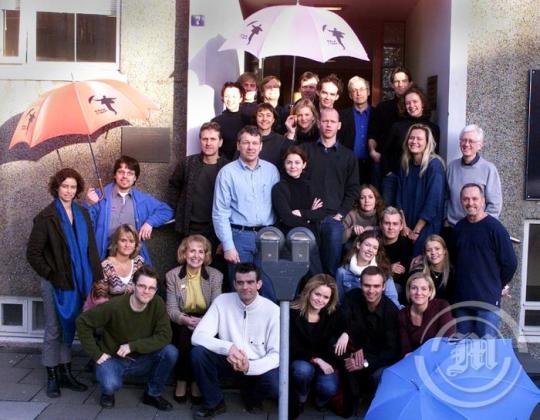
From the 3rd of Feburary 2001
Original Caption:
Sungið í rigningunni
ÆFINGAR hófust á fimmtudag í Þjóðleikhúsinum á söngleiknum Syngjandi í rigningunni eftir Betty Comden, Adolph Green, Nacio Herb Brown og Arthur Freed. Í stærstu hlutverkum eru Rúnar Freyr Gíslason, Selma Björnsdóttir, Stefán Karl Stefánsson og Þórunn Lárusdóttir. Þýðandi er Karl Ágúst Úlfsson.Tónlistar- og hljómsveitarstjóri er Jóhann G. Jóhannsson ásamt 8 hljóðfæraleikurum. Aðstoðarleikstjóri er Þórhallur Sigurðsson. Leikmynd gerir Sigurjón Jóhannsson og búninga Elín Edda Árnadóttir. Lýsingu hannar Páll Ragnarsson og um hljóðstjórn sér Sveinn Kjartansson. Aðrir leikarar eru Bjartmar Þórðarson, Guðmundur Ingi Þorvaldsson, Inga María Valdimarsdóttir, Jóhann Freyr Björgvinsson, Jóhann Örn Ólafsson, Jón Páll Eyjólfsson, Júlía Gold, Kjartan Guðjónsson, Linda Ásgeirsdóttir, Marta Nordal, Pálmi Árni Gestsson, Sigríður Þorvaldsdóttir, Sigrún Waage, Sveinbjörg Þórhallsdóttir, Valur Freyr Einarsson, Vigdís Gunnarsdóttir, Þórunn Clausen og fleiri. Sýningarstjóri er Kristín Hauksdóttir. MYNDATEXTI: Það er stór hópur leikhúsfólks sem mun syngja og dansa í rigningunni í Þjóðleikhúsinu.
Translation:
Singin' in the Rain
REHEARSALS began on Thursday at the National Theater with the musical Singin' in the Rain by Betty Comden, Adolph Green, Nacio Herb Brown and Arthur Freed. The biggest roles are Rúnar Freyr Gíslason, Selma Björnsdóttir, Stefán Karl Stefánsson and Þórunn Lárusdóttir. The translator is Karl Ágúst Úlfsson. Music and orchestra conductor is Jóhann G. Jóhannsson along with 8 instrumentalists. Assistant director is Þórhallur Sigurðsson. Set design by Sigurjón Jóhannsson and costumes by Elín Edda Árnadóttir. The lighting is designed by Páll Ragnarsson and the sound control is by Sveinn Kjartansson. Other actors are Bjartmar Þórðarson, Guðmundur Ingi Þorvaldsson, Inga María Valdimarsdóttir, Jóhann Freyr Björgvinsson, Jóhann Örn Ólafsson, Jón Páll Eyjólfsson, Júlía Gold, Kjartan Guðjónsson, Linda Ásgeirsdóttir, Marta Nordal, Pálmi Árni Gestsson, Sigríður Þorvaldsdóttir, Sigrún Waage, Sveinbjörg Þórhallsdóttir , Valur Freyr Einarsson, Vigdís Gunnarsdóttir, Þórunn Clausen and more. Curator of the showing is Kristín Hauksdóttir. PHOTO TEXT: There is a large group of theater people who will sing and dance in the rain at the National Theater.
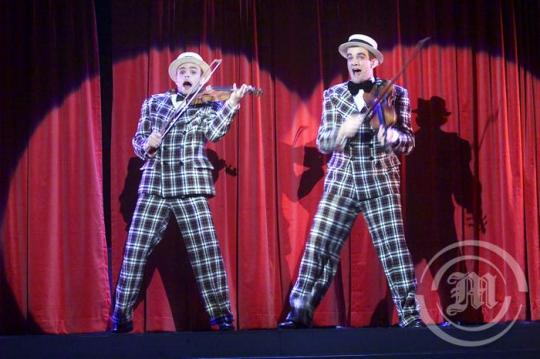
From the 6th of April 2001
Original Caption:
Úrhellisrigning á Stóra sviði Þjóðleikhússins
Í kvöld mun rigna á sviði Þjóðleikhússins en tilefnið er frumsýning á söngleiknum Syngjandi í rigningunni, sem hefst kl. 20. MYNDATEXTI: Rúnar Freyr Gíslason og Stefán Karl Stefánsson skemmta áhorfendum í Syngjandi í rigningunni..
Translation:
Heavy rain on the Grand Stage of the National Theater
Tonight it will rain on the stage of the National Theater, the occasion being the premiere of the musical Singin' in the Rain, which starts at 20. PHOTO TEXT: Rúnar Freyr Gíslason and Stefán Karl Stefánsson entertain the audience in Singin' in the Rain ..
Photo by Jón Svavarsson
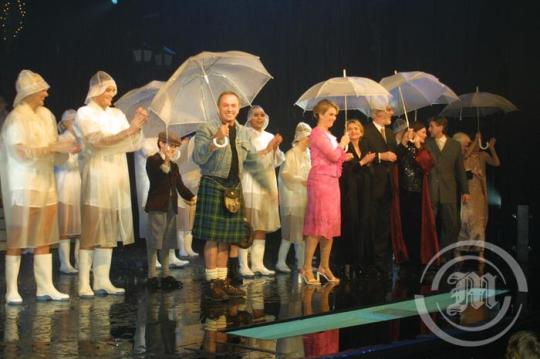
From the 10th of April 2001
Original Caption:
Söngleikurinn Syngjandi í rigningunni var frumsýndur í Þjóðleikhúsinu sl. föstudag við góðar undirtektir áhorfenda og gagnrýnenda. Myndatexti. Kenn Oldfield og listamennirnir fengur góðar viðtökur að frumsýningu lokinni.
Translation:
The musical Singin' in the Rain premiered at the National Theater recently. At friday with good reception from the audience and critics. Photo text. Kenn Oldfield and the artists are well received after the premiere.
Photo by Sigurður Jökull
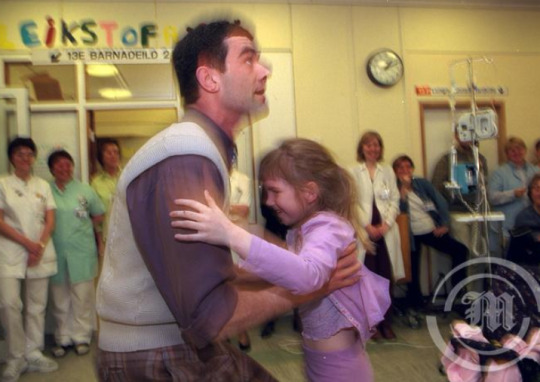
From the 17th of May 2001
Original Caption:
Sungið á sjúkrahúsinu
ÞAÐ VAR kátt á hjalla á Barnaspítala Hringsins í gær þegar leikarar úr söngleiknum Syngjandi í rigningunni heimsóttu krakkana. MYNDATEXTI: Stefán Karl fór á kostum í heimsókn þjóðleikhússleikara á Barnaspítala Hringsins.
Translation:
Sing in the hospital
IT WAS cheerful on the terrace at Hringinn Children's Hospital yesterday when actors from the musical Singing in the Rain visited the kids. PHOTO TEXT: Stefán Karl took advantage of the national theater actors visit to the Hringur Children's Hospital.
Photo by Jón Svavarsson
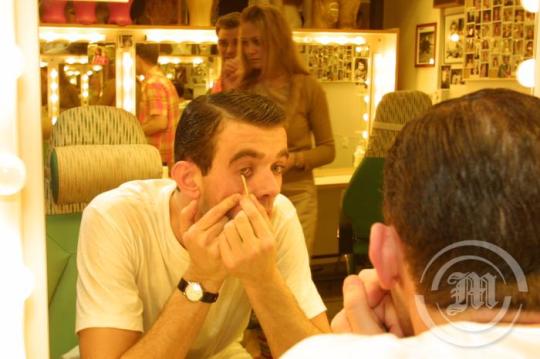
From the 14th of October 2001
Original Caption:
Að vera maður sjálfur Stefán Karl Stefánsson er einn af okkar ungu upprennandi leikurum. Um síðustu helgi var frumsýnt leikritið Vatn lífsins þar sem hann fer með aðalhlutverkið. MYNDATEXTI: "Ég hef líka verið að læra að fljúga og stefni að einkaflugmannsprófi í nánustu framtíð," segir Stefán Karl sem er hér að taka af sér sminkið eftir sýningu á Syngjandi í rigningunni. Stefán Karl tekur af sér sminkið.
Translation:
To be yourself
Stefán Karl Stefánsson is one of our young aspiring actors. Last weekend, the play Water of Life premiered, starring him. PHOTO CAPTION: "I have also been learning to fly and aim for a private pilot's exam in the near future," says Stefán Karl, who is here taking off his make-up after a show on Singin' in the Rain. Stefán Karl removes his make-up.
#stefán karl#stefán karl stefánsson#stefan karl#stefan karl stefansson#2001#singin' in the rain (2001)#water of life (2001)#youtube
6 notes
·
View notes